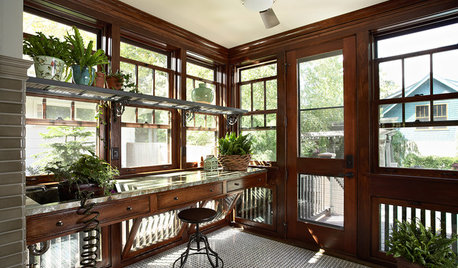overwintering dormant trees in pots
katrina1
15 years ago
Related Stories

FALL GARDENING6 Trees You'll Fall For
Don’t put down that spade! Autumn is the perfect time for planting these trees
Full Story
GARDENING GUIDESThe Beauty of Bare-Root Plants
Plant dormant trees and shrubs in fall using the easy, affordable bare-root method and enjoy beautiful results in spring
Full Story
WINTER GARDENINGWinter Gardening: Ideas for a Dream Potting Room
Check out potting rooms that get indoor gardening right — and learn tips for creating your own
Full Story
STUDIOS AND WORKSHOPSRoom of the Day: Potting and Puttering in Toasty Warmth
Minnesota winters are no match for this heated potting room, mudroom and changing room, which even has a dog shower
Full Story
SPRING GARDENINGHow to Grow a Rose Garden in Pots
Everything can come up roses, even without a plot of soil in sight. This step-by-step guide to growing roses in containers shows you how
Full Story
GARDENING GUIDES5 Best-Behaved Trees to Grace a Patio
Big enough for shade but small enough for easy care, these amiable trees mind their manners in a modest outdoor space
Full Story
GARDENING GUIDESHow to Keep Your Citrus Trees Well Fed and Healthy
Ripe for some citrus fertilizer know-how? This mini guide will help your lemon, orange and grapefruit trees flourish
Full Story
EDIBLE GARDENSHow to Grow 10 Favorite Fruit Trees at Home
Plant a mini orchard in fall, winter or early spring to enjoy fresh-off-the-tree fruit the following year
Full Story
GARDENING GUIDESSpring Citrus Care Reaps Months of Sweet Rewards
Learn how to tend citrus trees in spring and ways to preserve their delicious fruit
Full Story
FRUIT TREESHow to Grow Your Own Juicy Plums
Easier than other stone fruits and with a variety of colors to choose from, plums are a versatile garden addition
Full Story








l_james
greekman
Related Professionals
River Forest Landscape Architects & Landscape Designers · Battle Ground Landscape Contractors · Indianapolis Landscape Contractors · Louisville Landscape Contractors · Madera Landscape Contractors · San Carlos Park Landscape Contractors · Seminole Landscape Contractors · Tustin Landscape Contractors · Annapolis Siding & Exteriors · Colorado Springs Siding & Exteriors · South Plainfield Siding & Exteriors · Worcester Siding & Exteriors · Gastonia Decks, Patios & Outdoor Enclosures · Hialeah Decks, Patios & Outdoor Enclosures · Glendale Decks, Patios & Outdoor Enclosuresken_adrian Adrian MI cold Z5
katrina1Original Author
ken_adrian Adrian MI cold Z5
wisconsitom
katrina1Original Author
mad_gallica (z5 Eastern NY)
sequoia_stiffy
katrina1Original Author
lou_spicewood_tx
katrina1Original Author
sequoia_stiffy
katrina1Original Author